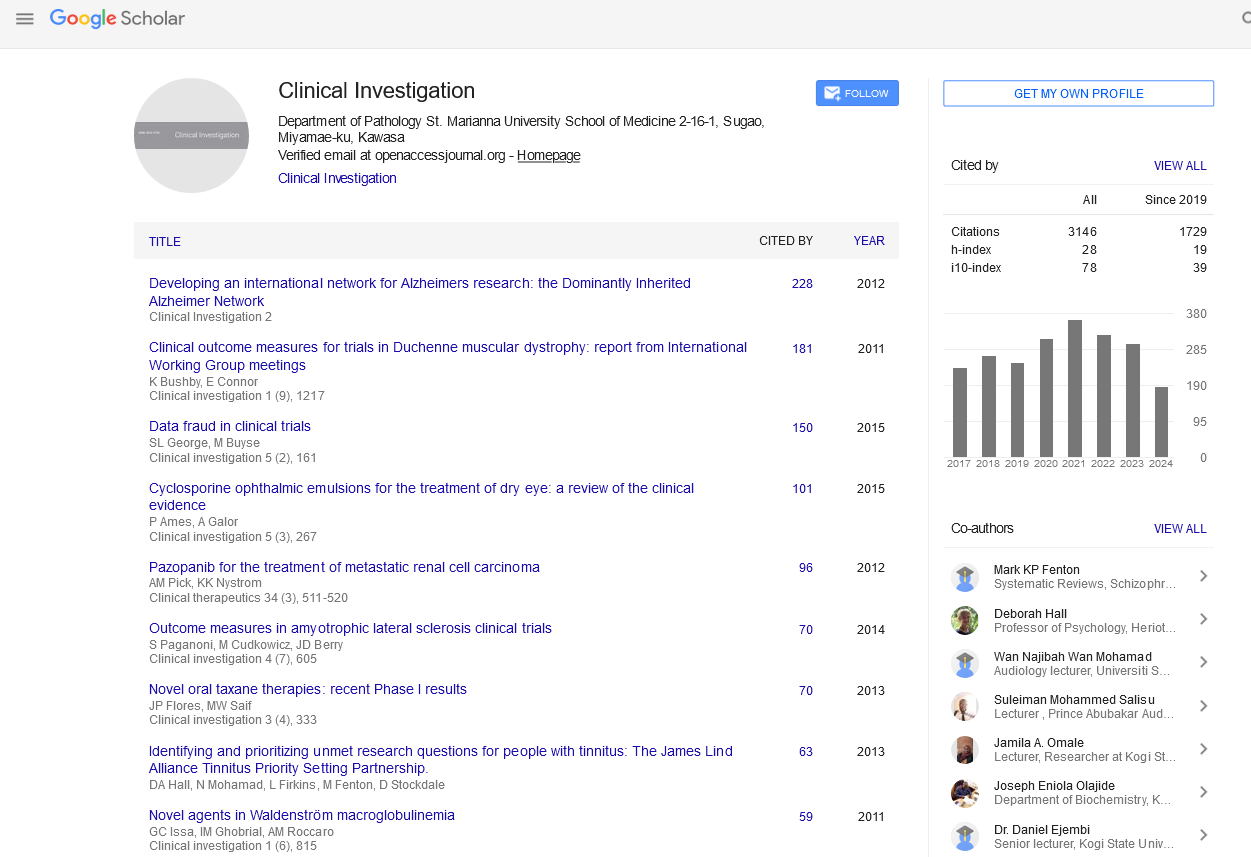Perspective - Clinical Investigation (2024) Volume 14, Issue 1
The Promise of Stem Cell Research in Regenerative Medicine
- Corresponding Author:
- Anurag Kasyup
Faculty of Biology, Kurushetra University, India
E-mail: anuragkasyup@gmail.com
Received: 3-Jan-2024, Manuscript No. fmci-24-159137; Editor assigned: 5-Jan-2024, PreQC No. fmci24-159137(PQ); Reviewed: 11-Jan-2024, QC No. fmci-24-159137(Q); Revised: 18-Jan-2024, Manuscript No. fmci-24-159137(R); Published: 24-Jan-2024
Abstract
Stem cell research offers exciting potential for regenerative medicine, with the promise of restoring function to damaged tissues and organs. Stem cells have the unique ability to differentiate into a variety of specialized cell types, making them invaluable tools for tissue repair and regeneration. This article explores the types of stem cells, their applications in treating diseases and injuries, and the challenges that must be overcome to fully realize their therapeutic potential. With the ability to regenerate damaged tissues, stem cell therapies hold promise for treating conditions ranging from spinal cord injuries to heart disease and neurodegenerative disorders.
Keywords
Stem cells • Regenerative medicine • Pluripotent stem cells • Multipotent stem cells • Induced pluripotent stem cells • Tissue repair • Regenerative therapies • Genetic diseases • Spinal cord • Injuries • Heart disease
Introduction
Stem cell research is one of the most promising areas of biomedical research, offering the potential to revolutionize the treatment of numerous diseases and injuries. Stem cells have the remarkable ability to differentiate into various types of specialized cells, allowing them to repair or replace damaged tissues. This regenerative capability makes them an invaluable resource in the field of regenerative medicine, which aims to restore or replace damaged tissues and organs.
Over the past few decades, stem cell research has made significant progress, and therapies derived from stem cells are now being used in clinical practice. Stem cells have the potential to treat a variety of conditions, including spinal cord injuries, heart disease, diabetes, and neurodegenerative disorders like Parkinson’s and Alzheimer’s disease. However, significant challenges remain in terms of safety, efficacy, and ethical concerns surrounding the use of stem cells.
This article provides an overview of stem cell research, highlighting the different types of stem cells, their therapeutic applications, and the future directions of stem cell-based therapies.
Types of stem cells
Stem cells can be broadly classified into two categories: Embryonic Stem Cells (ESCs) and Adult Stem Cells (ASCs). Each type of stem cell has its own unique characteristics and applications in regenerative medicine.
• Embryonic Stem Cells (ESCs): ESCs are pluripotent, meaning they can develop into any cell type in the body. These cells are typically derived from early-stage embryos and have the greatest potential for regenerative medicine. However, the use of ESCs raises ethical concerns, as obtaining these cells requires the destruction of embryos.
• Adult Stem Cells (ASCs): ASCs, also known as somatic or tissue-specific stem cells, are found in various tissues throughout the body. These cells are multipotent, meaning they can differentiate into a limited number of cell types. ASCs are used more commonly in clinical applications because they are less controversial than ESCs. For example, hematopoietic stem cells (HSCs) are used in bone marrow transplants for leukemia and other blood disorders.
• Induced Pluripotent Stem Cells (iPSCs): iPSCs are adult cells that have been reprogrammed to exhibit pluripotency, meaning they can differentiate into a variety of cell types. iPSCs offer a promising alternative to ESCs because they do not involve the use of embryos. Research into iPSCs is still in its early stages, but they have the potential to be used in a wide range of therapies without the ethical concerns associated with ESCs.
Applications of stem cells in regenerative medicine
Stem cells have shown great potential in treating a variety of conditions. Some of the most promising applications of stem cell therapies include.
• Spinal cord injuries: Spinal cord injuries often lead to permanent loss of function due to nerve cell damage. Stem cell therapy aims to promote the regeneration of nerve cells and restore function in patients with spinal cord injuries. Clinical trials are underway to test the safety and efficacy of stem cell-based treatments for spinal cord injuries, with early results showing promising outcomes in terms of motor recovery.
• Heart disease: Cardiovascular disease, particularly heart failure following a heart attack, remains one of the leading causes of death worldwide. Stem cells are being investigated for their potential to repair damaged heart tissue. Stem cell-based therapies could help regenerate heart muscle, restore heart function, and reduce the need for heart transplants. Research in this area is still ongoing, but several earlystage clinical trials have demonstrated positive results.
• Neurodegenerative diseases: Diseases such as Parkinson’s, Alzheimer’s, and Huntington’s are characterized by the progressive loss of neurons in the brain. Stem cell therapies are being explored as a potential treatment for these conditions by replacing lost neurons and restoring normal brain function. Recent advancements in gene therapy and iPSC technology have opened new avenues for stem cell treatments for neurodegenerative diseases.
Challenges and ethical considerations
Despite the promising potential of stem cell therapies, there are several challenges and ethical considerations that need to be addressed before these treatments can become widely available. Some of the key challenges include.
• Tumor formation: One of the risks associated with stem cell therapies is the potential for tumor formation. Stem cells can divide rapidly, and in some cases, they may form tumors instead of differentiated tissues. Researchers are working to identify methods to control stem cell differentiation and prevent tumor growth.
• Immune rejection: In some cases, stem cells may be derived from a donor or an embryo, which could lead to immune rejection when transplanted into patients. To overcome this, researchers are exploring the use of iPSCs, which can be derived from the patient’s own cells, reducing the risk of immune rejection.
Conclusion
Stem cell research offers immense potential for regenerative medicine, providing new hope for patients suffering from a range of diseases and injuries. Stem cells’ ability to regenerate damaged tissues and replace lost cells makes them invaluable tools for treating conditions such as spinal cord injuries, heart disease, and neurodegenerative disorders. However, there are still significant challenges to overcome in terms of safety, efficacy, and ethical considerations.
As research continues and stem cell therapies become more refined, the potential for these treatments to transform medicine is limitless. With the ongoing development of new technologies and the growing understanding of stem cell biology, the future of regenerative medicine looks promising, and stem cell therapies could one day provide cures for many of the most challenging diseases and injuries.


